In-Season Weightlifting Training Exercise in Healthy Male Handball Players: Effects on Body Composition, Muscle Volume, Maximal Strength, and Ball-Throwing Velocity
Abstract
1. Introduction
2. Materials and Methods
2.1. Ethical Clearance
2.2. Procedures and Evaluations
2.3. Testing Schedule
2.4. Experimental Approach to the Problem
2.5. Anthropometry
2.6. 1RM Bench Press (1RMBP)
2.7. 1RM Bench Snatch (1RMsnatch)
2.8. 1RM Clean and Jerk (1RMCJ)
2.9. 1RM Pull-Over (1RMPO)
2.10. Handball Throwing
2.11. Weightlifting Training Program
2.12. Statistical Analyses
3. Results
3.1. Changes in the Control Group and Experimental Group
3.1.1. Changes in the CG during the 8-Week Trial
3.1.2. Changes in the EG during the 8-Week Trial
3.2. Comparison of Experimental vs. Control Group
4. Discussion
4.1. Muscle Volume
4.2. Maximal Strength
4.3. Ball-Throwing Velocity
4.4. Practical Applications
5. Conclusions
Author Contributions
Funding
Acknowledgments
Conflicts of Interest
References
- Gorostiaga, E.M.; Izquierdo, M.; Iturralde, P.; Ruesta, M.; Ibanez, J. Effects of heavy resistance training on maximal and explosive force production, endurance and serum hormones in adolescent handball players. Eur. J. Appl. Physiol. Occup. Physiol. 1999, 80, 485–493. [Google Scholar] [CrossRef]
- Granados, C.; Izquierdo, M.; Ibanez, J.; Bonnabau, H.; Gorostiaga, E.M. Differences in physical fitness and throwing velocity among elite and amateur female handball players. Int. J. Sports Med. 2007, 28, 860–867. [Google Scholar] [CrossRef] [PubMed]
- Hermassi, S.; Delank, K.S.; Fieseler, G.; Bartels, T.; Chelly, M.S.; Khalifa, R.; Schwesig, R. Relationships Between Olympic Weightlifting Exercises, Peak Power of the Upper and Lower Limb, Muscle Volume and Throwing Ball Velocity in Elite Male Handball Players. Sportverletz Sportschaden 2018. [Google Scholar] [CrossRef] [PubMed]
- Hermassi, S.; Schwesig, R.; Aloui, G.; Shephard, R.J.; Chelly, M.S. Effects of short-term in-season weightlifting training on the muscle strength, peak power, sprint performance, and ball throwing velocity of male handball players. J. Strength Cond. Res. 2019. [Google Scholar] [CrossRef] [PubMed]
- Chelly, M.S.; Hermassi, S.; Shephard, R.J. Relationships between power and strength of the upper and lower limb muscles and throwing velocity in male handball players. J. Strength Cond. Res. 2010, 24, 1480–1487. [Google Scholar] [CrossRef]
- Fleck, S.J.; Smith, S.L.; Craib, M.W.; Denahan, T.; Snow, R.E.; Mitchell, M.R. Upper extremity isokinetic torque and throwing velocity in team handball. J. Appl. Sport Sci. Res. 1992, 6, 120–124. [Google Scholar] [CrossRef]
- Hermassi, S.; Chelly, M.S.; Tabka, Z.; Shephard, R.J.; Chamari, K. Effects of 8-week in-season upper and lower limb heavy resistance training on the peak power, throwing velocity, and sprint performance of elite male handball players. J. Strength Cond. Res. 2011, 25, 2424–2433. [Google Scholar] [CrossRef]
- Hermassi, S.; Chelly, M.S.; Fathloun, M.; Shephard, R.J. The effect of heavy- vs. moderate-load training on the development of strength, power, and throwing ball velocity in male handball players. J. Strength Cond. Res. 2010, 24, 2408–2418. [Google Scholar] [CrossRef]
- Aloui, G.; Hammami, M.; Fathloun, M.; Hermassi, S.; Gaamouri, N.; Shephard, R.J.; Chelly, M.S. Effects of an 8-Week In-Season Elastic Band Training Program on Explosive Muscle Performance, Change of Direction, and Repeated Changes of Direction in the Lower Limbs of Junior Male Handball Players. J. Strength Cond. Res. 2018. [Google Scholar] [CrossRef]
- Crewther, B.; Cronin, J.; Keogh, J. Possible stimuli for strength and power adaptation: Acute mechanical responses. Sports Med. 2005, 35, 967–989. [Google Scholar] [CrossRef]
- Tricoli, V.; Lamas, L.; Carnevale, R.; Ugrinowitsch, C. Short-term effects on lower-body functional power development: Weightlifting vs. vertical jump training programs. J. Strength Cond. Res 2005, 19, 433–437. [Google Scholar] [CrossRef] [PubMed]
- Chaouachi, A.; Hammami, R.; Kaabi, S.; Chamari, K.; Drinkwater, E.J.; Behm, D.G. Olympic weightlifting and plyometric training with children provides similar or greater performance improvements than traditional resistance training. J. Strength Cond. Res. 2014, 28, 1483–1496. [Google Scholar] [CrossRef] [PubMed]
- Helland, C.; Hole, E.; Iversen, E.; Olsson, M.C.; Seynnes, O.; Solberg, P.A.; Paulsen, G. Training Strategies to Improve Muscle Power: Is Olympic-style Weightlifting Relevant? Med. Sci. Sports Exerc. 2017, 49, 736–745. [Google Scholar] [CrossRef] [PubMed]
- Newton, R.U.; Kraemer, W.J.; Hakkinen, K. Effects of ballistic training on preseason preparation of elite volleyball players. Med. Sci. Sports Exerc. 1999, 31, 323–330. [Google Scholar] [CrossRef]
- Ebben, W.P.; Carroll, R.M.; Simenz, C.J. Strength and conditioning practices of National Hockey League strength and conditioning coaches. J. Strength Cond. Res. 2004, 18, 889–897. [Google Scholar] [CrossRef]
- Hoffman, J.R.; Cooper, J.; Wendell, M.; Kang, J. Comparison of Olympic vs. traditional power lifting training programs in football players. J. Strength Cond. Res. 2004, 18, 129–135. [Google Scholar]
- Johns, R.A.; Houmard, J.A.; Kobe, R.W.; Hortobagyi, T.; Bruno, N.J.; Wells, J.M.; Shinebarger, M.H. Effects of taper on swim power, stroke distance, and performance. Med. Sci. Sports Exerc. 1992, 24, 1141–1146. [Google Scholar] [CrossRef]
- Shephard, R.J.; Vandewalle, H.; Bouhlel, E.; Monod, H. Sex differences of physical working capacity in normoxia and hypoxia. Ergonomics 1988, 31, 1177–1192. [Google Scholar] [CrossRef]
- Womersley, J.; Durnin, J.V. An experimental study on variability of measurements of skinfold thickness on young adults. Hum. Biol. 1973, 45, 281–292. [Google Scholar]
- McArdle, W.; Katch, F.; Katch, V. Exercise Physiology: Energy, Nutrition & Human Performance; Lippincott Williams &Wilkins: Baltimore, MD, USA, 2007. [Google Scholar]
- Chelly, M.S.; Fathloun, M.; Cherif, N.; Ben Amar, M.; Tabka, Z.; Van Praagh, E. Effects of a back squat training program on leg power, jump, and sprint performances in junior soccer players. J. Strength Cond. Res. 2009, 23, 2241–2249. [Google Scholar] [CrossRef] [PubMed]
- Arabatzi, F.; Kellis, E.; De Villarreal, E.S.S. Vertical jump biomechanics after plyometric, weight lifting, and combined (weight lifting + plyometric) training. J. Strength Cond. Res. 2010, 24, 2440–2448. [Google Scholar] [CrossRef] [PubMed]
- Cohen, J. Statistical Power Analysis for the Behavioural Sciences, 2nd ed.; Lawrence Erlbaum: Hillsdale, NJ, USA, 1988. [Google Scholar]
- Hartmann, A.; Herzog, T.; Drinkmann, A. Psychotherapy of bulimia nervosa: What is effective? A meta-analysis. J. Psychosom. Res. 1992, 36, 159–167. [Google Scholar] [CrossRef]
- Gorostiaga, E.M.; Granados, C.; Ibanez, J.; Izquierdo, M. Differences in physical fitness and throwing velocity among elite and amateur male handball players. Int. J. Sports Med. 2005, 26, 225–232. [Google Scholar] [CrossRef] [PubMed]
- Hermassi, S.; Wollny, R.; Schwesig, R.; Shephard, R.J.; Chelly, M.S. Effects of in-season circuit training on physical abilities in male handball players. J. Strength Cond. Res. 2017, 31, 944–957. [Google Scholar] [CrossRef] [PubMed]
- Chelly, M.S.; Hermassi, S.; Aouadi, R.; Shephard, R.J. Effects of 8-week in-season plyometric training on upper and lower limb performance of elite adolescent handball players. J. Strength Cond. Res. 2014, 28, 1401–1410. [Google Scholar] [CrossRef] [PubMed]
- Behm, D.G. Neuromuscular implications and applications of resistance training. J. Strength Cond. Res. 1995, 9, 264–274. [Google Scholar] [CrossRef]
- Hermassi, S.; van den Tillaar, R.; Khlifa, R.; Chelly, M.S.; Chamari, K. Comparison of In-Season-Specific Resistance vs. A Regular Throwing Training Program on Throwing Velocity, Anthropometry, and Power Performance in Elite Handball Players. J. Strength Cond. Res. 2015, 29, 2105–2114. [Google Scholar] [CrossRef]
- Lieber, R.L.; Fridén, J. Muscle damage is not a function of muscle force but active muscle strain. J. Appl. Physiol. 1993, 74, 520–526. [Google Scholar] [CrossRef]
- Fowles, J.R.; MacDougall, J.D.; Tarnopolsky, M.A.; Sale, D.G.; Roy, B.D.; Yarasheski, K.E. The effects of acute passive stretch on muscle protein synthesis in humans. Can. J. Appl. Physiol. 2000, 25, 165–180. [Google Scholar] [CrossRef]
- Gonzalez-Badillo, J.J.; Izquierdo, M.; Gorostiaga, E.M. Moderate volume of high relative training intensity produces greater strength gains compared with low and high volumes in competitive weightlifters. J. Strength Cond. Res. 2006, 20, 73–81. [Google Scholar] [CrossRef]
- Gibala, M.J.; Macdougall, J.D.; Sale, D.G. The effects of tapering on strength performance in trained athletes. Int. J. Sports Med. 1994, 15, 492–497. [Google Scholar] [CrossRef] [PubMed]
- Marques, M.C.; van den Tillaar, R.; Vescovi, J.D.; Gonzalez-Badillo, J.J. Relationship between throwing velocity, muscle power, and bar velocity during bench press in elite handball players. Int. J. Sports Physiol. Perform. 2007, 2, 414–422. [Google Scholar] [CrossRef] [PubMed]
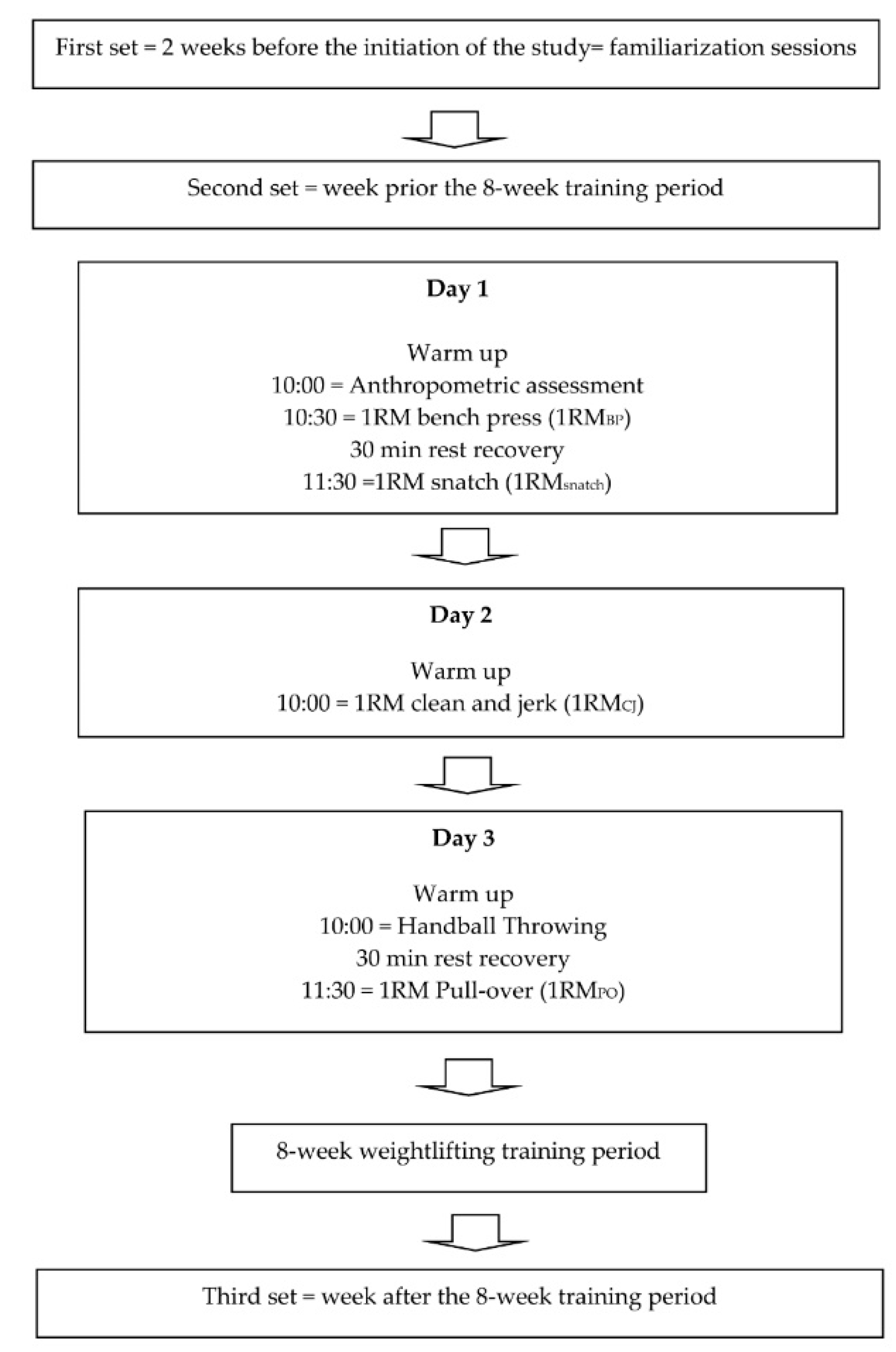
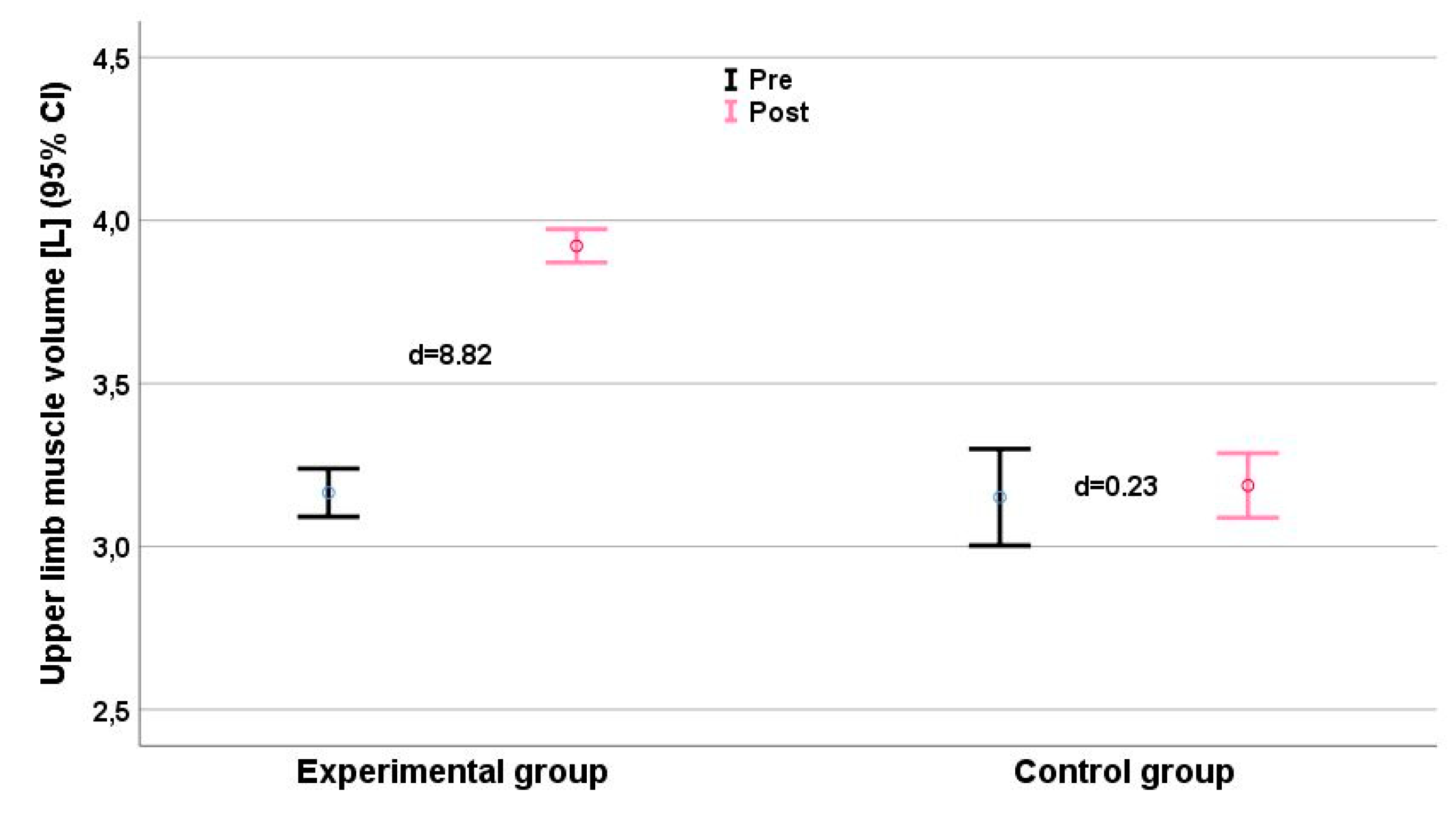

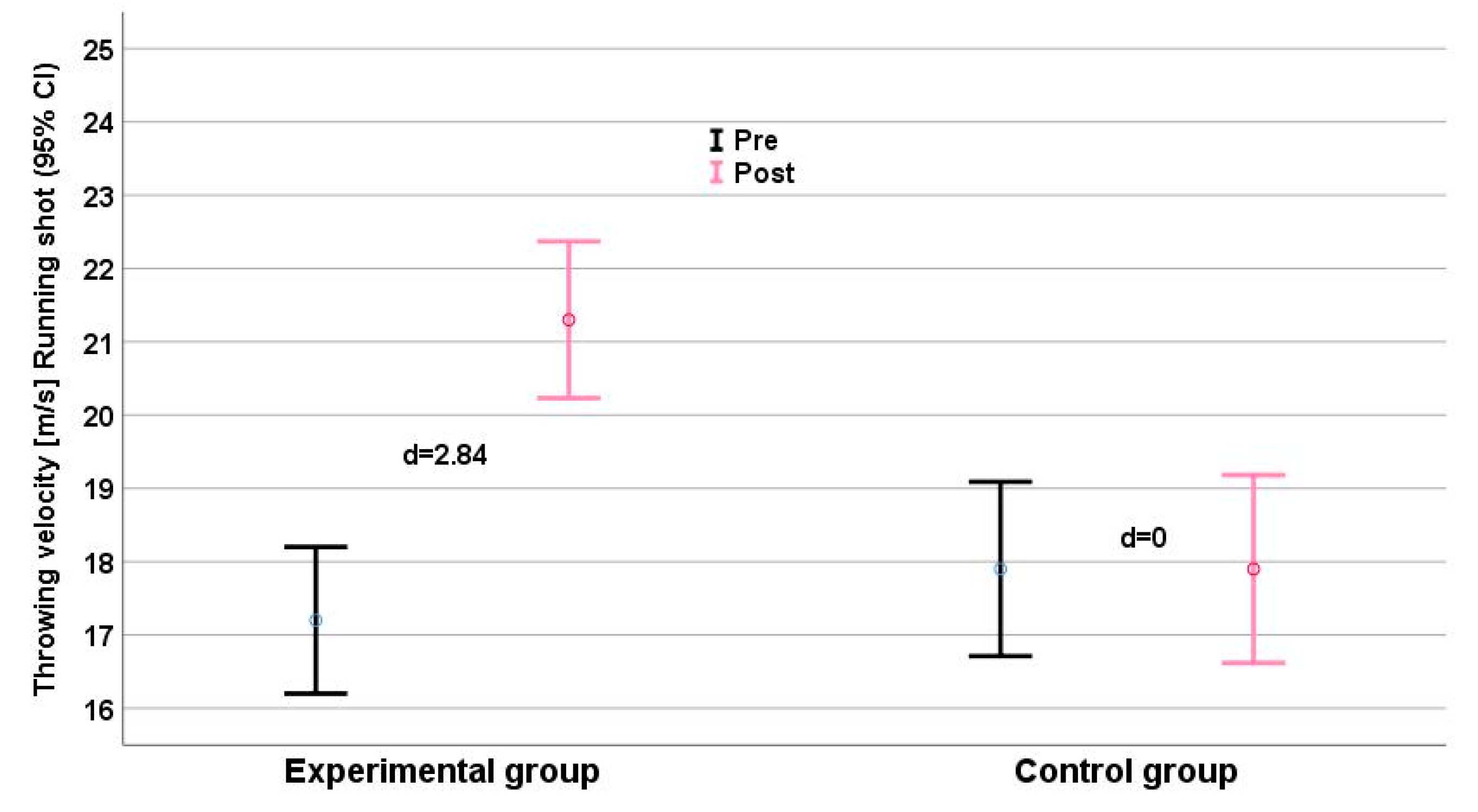
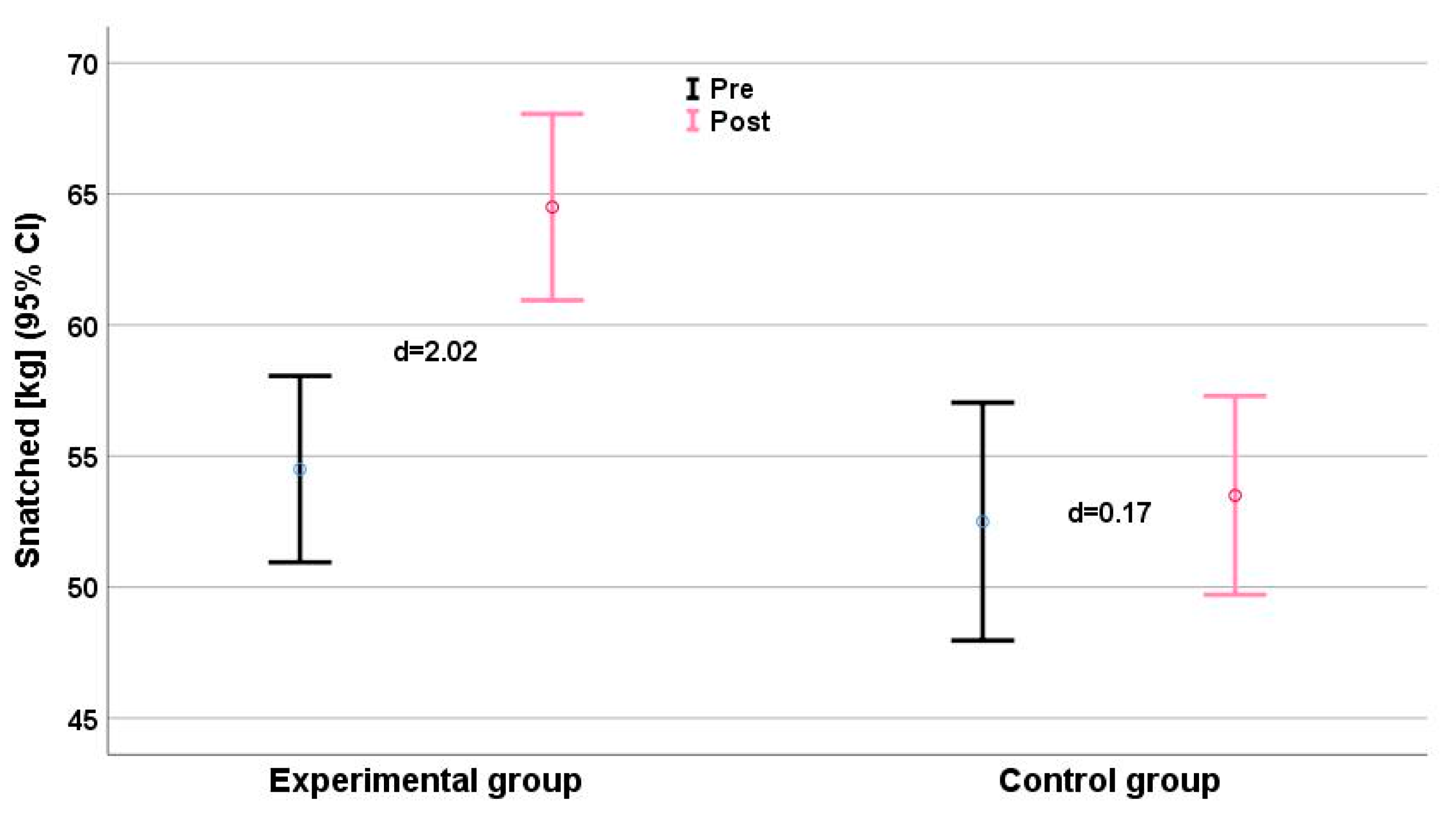
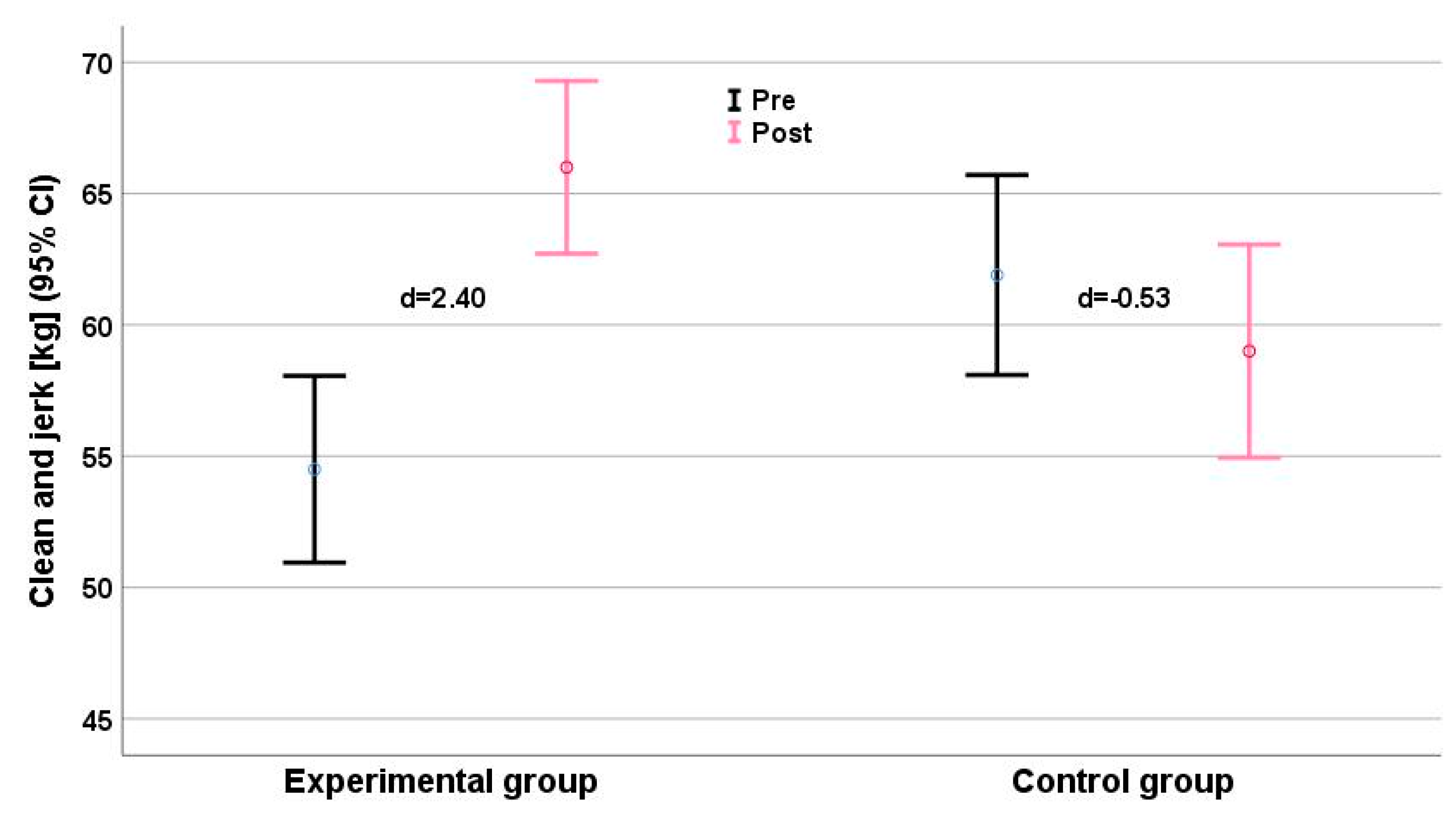
| Exercises | Session 1 | Session 2 | Session 3 | Session 4 | Session 5 | Session 6 |
| Clean and Jerk | 55: 3 × 6 | 55: 3 × 8 | 60: 3 × 6 | 60: 3 × 8 | 60: 4 × 6 | 60: 4 × 6 |
| Bench press | 55: 3 × 6 | 55: 3 × 8 | 60: 3 × 6 | 60: 3 × 8 | 60: 4 × 6 | 60: 4 × 6 |
| Snatches | 55: 3 × 8 | 55: 3 × 10 | 60: 3 × 8 | 60: 3 × 10 | 60: 4 × 8 | 60: 4 × 6 |
| Pull-over | 55: 3 × 8 | 55: 3 × 10 | 60: 3 × 8 | 60: 3 × 10 | 60: 4 × 8 | 60: 3 × 6 |
| Exercises | Session 7 | Session 8 | Session 9 | Session 10 | Session 11 | Session 12 |
| Clean and Jerk | 65: 3 × 6 | 65: 4 × 6 | 70: 3 × 5 | 70: 4 × 5 | 75: 3 × 5 | 70: 3 × 6 |
| Bench press | 65: 3 × 6 | 65: 4 × 6 | 70: 3 × 5 | 70: 4 × 5 | 75: 3 × 5 | 60: 4 × 6 |
| Snatches | 65: 3 × 8 | 65: 4 × 8 | 70: 3 × 5 | 70: 4 × 6 | 75: 3 × 6 | 60: 4 × 6 |
| Pull-over | 65: 3 × 8 | 65: 4 × 8 | 70: 3 × 6 | 70: 4 × 6 | 75: 3 × 6 | 70: 2 × 6 |
| Exercises | Session 13 | Session 14 | Session 15 | Session 16 | ||
| Clean and Jerk | 75: 4 × 4 | 80: 3 × 3 | 80: 3 × 4 | 85: 3 × 3 | ||
| Bench press | 75: 4 × 4 | 80: 3 × 3 | 80: 3 × 4 | 85: 3 × 3 | ||
| Snatches | 75: 4 × 5 | 80: 3 × 3 | 80: 4 × 3 | 85: 4 × 3 | ||
| Pull-over | 75: 3 × 5 | 80: 3 × 3 | 80: 4 × 3 | 85: 4 × 3 |
| Tests | Session One Mean ± SD | Session Two Mean ± SD | ICC (95% CI) |
|---|---|---|---|
| standing shot (m/s) | 23.9 ± 2.86 | 23.4 ± 2.78 | 0.80 (0.50–0.92) |
| jump shot (m/s) | 21.0 ± 1.76 | 19.7 ± 1.93 | 0.82 (0–0.95) |
| running shot (m/s) | 17.6 ± 1.54 | 16.9 ± 1.55 | 0.90 (0.50–0.97) |
| snatches (kg) | 53.5 ± 5.64 | 50.5 ± 6.67 | 0.83 (0.41–0.94) |
| clean and jerk (kg) | 58.2 ± 6.29 | 52.0 ± 6.37 | 0.58 (0–0.85) |
| pull over (kg) | 37.9 ± 4.84 | 36.8 ± 4.94 | 0.89 (0.73–0.96) |
| bench press (kg) | 73.3 ± 5.20 | 69.3 ± 4.94 | 0.74 (0–0.92) |
| Parameter | Experimental Group (n = 10) | Control Group (n = 10) | Variance Analysis/Effects | |||||||
|---|---|---|---|---|---|---|---|---|---|---|
| Pre | Post | Pre | Post | Time | Group × Time | |||||
| d | d | p | ηp2 | p | ηp2 | |||||
| Body mass (kg) | 86.5 ± 5.0 | 84.4 ± 4.6 | 0.44 | 80.0 ± 8.5 | 80.0 ± 8.1 | 0 | 0.002 | 0.433 | 0.002 | 0.433 |
| Body fat (%) | 13.8 ± 0.6 | 13.4 ± 0.6 | 0.66 | 12.7 ± 1.7 | 12.7 ± 1.6 | 0 | 0.001 | 0.462 | 0.003 | 0.391 |
| Upper limb muscle volume (L) | 3.2 ± 0.1 | 3.9 ± 0.1 | 7.00 | 3.1 ± 0.2 | 3.2 ± 0.1 | 0.23 | <0.001 | 0.933 | <0.001 | 0.920 |
| Parameter | Experimental Group (n = 10) | Control Group (n = 10) | Variance Analysis/Effects | |||||||
|---|---|---|---|---|---|---|---|---|---|---|
| Pre | Post | Pre | Post | Time | Group × Time | |||||
| d | d | p | ηp2 | p | ηp2 | |||||
| Throwing velocity | ||||||||||
| Standing shot (m/s) | 23.7 ± 3.6 | 29.0 ± 4.0 | 1.40 | 24.1 ± 2.1 | 23.7 ± 1.8 | −0.21 | <0.001 | 0.530 | <0.001 | 0.603 |
| Jump shot (m/s) | 20.2 ± 1.0 | 23.4 ± 1.3 | 2.78 | 21.8 ± 2.0 | 20.9 ± 2.4 | −0.41 | <0.001 | 0.530 | <0.001 | 0.777 |
| Running shot (m/s) | 17.2 ± 1.4 | 21.3 ± 1.5 | 2.84 | 17.9 ± 1.7 | 17.9 ± 1.8 | 0 | <0.001 | 0.771 | <0.001 | 0.771 |
| Medicine ball throw (m) | 18.5 ± 1.9 | 26.0 ± 1.2 | 4.84 | 18.1 ± 1.6 | 17.8 ± 1.2 | −0.21 | <0.001 | 0.870 | <0.001 | 0.887 |
| Maximal strength performance (kg) | ||||||||||
| Snatch | 54.5 ± 4.9 | 64.5 ± 5.0 | 2.02 | 52.5 ± 6.3 | 53.5 ± 5.3 | 0.17 | <0.001 | 0.761 | <0.001 | 0.681 |
| Clean and jerk | 54.5 ± 5.0 | 66.0 ± 4.6 | 2.40 | 61.9 ± 5.3 | 59.0 ± 5.7 | −0.53 | <0.001 | 0.537 | <0.001 | 0.764 |
| Pull-over | 39.3 ± 4.8 | 48.0 ± 5.2 | 1.75 | 36.5 ± 4.7 | 36.5 ± 2.4 | 0 | <0.001 | 0.595 | <0.001 | 0.595 |
| Bench press | 73.5 ± 4.7 | 83.5 ± 4.7 | 2.11 | 73.0 ± 5.9 | 72.5 ± 5.4 | −0.09 | <0.001 | 0.862 | 0.001 | 0.884 |
© 2019 by the authors. Licensee MDPI, Basel, Switzerland. This article is an open access article distributed under the terms and conditions of the Creative Commons Attribution (CC BY) license (http://creativecommons.org/licenses/by/4.0/).
Share and Cite
Hermassi, S.; Chelly, M.S.; Bragazzi, N.L.; Shephard, R.J.; Schwesig, R. In-Season Weightlifting Training Exercise in Healthy Male Handball Players: Effects on Body Composition, Muscle Volume, Maximal Strength, and Ball-Throwing Velocity. Int. J. Environ. Res. Public Health 2019, 16, 4520. https://doi.org/10.3390/ijerph16224520
Hermassi S, Chelly MS, Bragazzi NL, Shephard RJ, Schwesig R. In-Season Weightlifting Training Exercise in Healthy Male Handball Players: Effects on Body Composition, Muscle Volume, Maximal Strength, and Ball-Throwing Velocity. International Journal of Environmental Research and Public Health. 2019; 16(22):4520. https://doi.org/10.3390/ijerph16224520
Chicago/Turabian StyleHermassi, Souhail, Mohamed Souhaiel Chelly, Nicola Luigi Bragazzi, Roy J Shephard, and René Schwesig. 2019. "In-Season Weightlifting Training Exercise in Healthy Male Handball Players: Effects on Body Composition, Muscle Volume, Maximal Strength, and Ball-Throwing Velocity" International Journal of Environmental Research and Public Health 16, no. 22: 4520. https://doi.org/10.3390/ijerph16224520
APA StyleHermassi, S., Chelly, M. S., Bragazzi, N. L., Shephard, R. J., & Schwesig, R. (2019). In-Season Weightlifting Training Exercise in Healthy Male Handball Players: Effects on Body Composition, Muscle Volume, Maximal Strength, and Ball-Throwing Velocity. International Journal of Environmental Research and Public Health, 16(22), 4520. https://doi.org/10.3390/ijerph16224520








